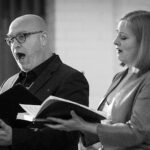
Twin Peaks Middle School students talk to singing sensation Taylor Swift, via Skype on Tuesday. Photo: Gina Yarbrough/San Diego County News
By Ragna Cook
POWAY–There was a buzz of excited energy from a group of twelve to fourteen-year-old students from Twin Oaks Middle School in Poway on Tuesday as they waited for seven-time Grammy winner Taylor Swift to join them via Skype for a special group interview sponsored by Scholastic.
“I’m really looking forward to see how Taylor presents her creativity, not only in her songs but maybe what inspires her, in terms of books she likes to read or her workmanship,” Tiffany Daher, a language arts teacher at the school for nearly five years, said. Daher’s class got selected because Daher is on the national advisory board for Scholastic, and she believes Scholastic chose them because she uses Scholastic materials in her classroom.
Micah Loy, an eighth grader at the school, was especially excited to see her. “I really like her music, how she sings.” He was also interested in what books she would like to read.
Megan Chavez, another student, said being picked for the experience was very cool. “I’m really excited. It’s really awesome to be here,” she said. “I’m looking forward to see how she kind of thinks of things. She could pass on some really good advice to use, probably.”
Even though there were delays, when Swift arrived the excitement grew even more, and Swift seemed just as excited as the students picked from Daher’s class, as well as the other teens and preteens selected for the special interview, which would be included in a video Scholastic released on Wednesday in support of their “Open a World of Possible” initiative. The initiative is a campaign that reaches out to teachers, parents and children across the broad spectrum of products that Scholastic offers, including books, magazines and websites. There is also a contest offered to students in grades 3 – 8 called “This Is How I Shake It Off,” that aims to have children write a one-page creative essay or poem about how they can shake off mean comments and hard times (more details can be found at http://www.scholastic.com/taylorswift).
Swift was asked a variety of questions from the six students in the room with her, as well as a question each from the schools participating via Skype. They ranged from favorite female characters to what her writing process was to what inspired her songs, and Swift answered all the questions with a vibrancy that showed that the answers she gave were things she was incredibly passionate about, and the children involved in the interview, as well as the countless others who will view the video, will be able to see a side of Swift that shows just how important reading and writing are to her. Swift is an ideal celebrity to encourage children of all ages to become passionate themselves about the things they read and the things they write, especially when they write to better learn about themselves.
The first question, which asked about female characters that influenced her in the books she read growing up, mentioned Emma Watson’s speech that she gave to the UN about the “He For She” campaign and Swift’s positive reaction to that speech. “I really do love what she said about feminism, and I love it when women and girls can identify with feminism, and that discussion becomes more popular,” she said. “When I was growing up I feel like it wasn’t something that we really talked about, we really didn’t understand what feminism was. If we did we thought it was some angry kind of aggressive thing, and it’s not. It’s just that you believe that men and women should have equal rights and opportunities.”
She went on to say that Watson’s character from the Harry Potter series, Hermione Granger, was an amazing character in literature. She also mentioned the book Stargirl, written by Jerry Spinelli, which features a character, Susan Caraway, that Swift says is different and because of that she is teased. Throughout the book she “continues to be herself and pretty soon, that individuality rubs off on everyone else and they all want to be like her.” Another book she brought up was John Green’s The Fault In Our Stars, speaking about the female protagonist Hazel Grace being “so smart and sarcastic and self-aware,” and that Green did a good job of “painting a really really intricate, beautiful, complicated female character.”
Having kept journals growing up she supports people keeping journals to record their thoughts and feelings. “I’ve been journaling since I was thirteen. I have all the journals of when I was in school,” she said. She believes journaling is something anyone could use to discover other things they love in regards to creating things themselves. “If you just start to write in your free time, and you make writing something that you look forward to, who knows where it will take you? Who knows if you’ll start to think about storylines and you’ll decide that you want to write a book someday, or you’ll decide that maybe you like journalism, or you’ll sketch something and realize that you want to be an artist. There are so many different things you can discover about yourself if you write.”
Swift then talked about some of the things she experienced in school when it came to what she wrote down in her journals. She said people would say “Taylor ‘s annoying, Taylor’s weird, we don’t want to hang out with her,” something she joked that people still said about her today, and she talked about loneliness and how she was left out of the things her classmates did. “I would be sad that I wasn’t invited to some party that everybody was invited to or you know, upset that some boy that I had a crush on didn’t notice me,” Swift said. She went on to say that it was easier to understand things when you wrote them down. “Sometimes nothing can really make you feel better about what you’re going through but a lot of the time it’s easier to understand how you’re feeling if you write it down, cause it kind of simplifies it for you. A lot of the time we get so overwhelmed by our emotions because there are so many of them, but a lot of the time if you put pen to paper, how you’re actually feeling will be what comes out on the page.”

Class instructor Tiffany Daher, far right, with her students. Photo: Gina Yarbrough/San Diego County News
Swift stated that she does draw upon real life experiences, such as the things she’s journaled about, to create the songs that she writes. “My real life experiences are pretty much all I draw from when I write songs,” Swift said. “When you put out an album of all these new songs, it’s like people are opening up your diary and reading it, and going ‘Oh! I guess that’s what she went through’ and ‘I guess she went through that, too.'” One specific example she shared when it came to music she had written that was about something that affected her was the song “Mean,” from her album “Speak Now,” which is about “a guy picking on me and making me feel small and making me feel like I wasn’t enough or I wasn’t what I should be,” according to Swift. “I thought that when you grow up and you graduate high school or something that people don’t bully each other anymore, and that you don’t have to feel that people are picking on you all the time or saying things that aren’t true about you or saying that you don’t deserve what you want.”
She found that this wasn’t true, however. About two albums in, according to Swift, there was a critic who “decided that I just didn’t deserve anything I had and was just saying all these things about me that were just mean spirited.” This particular critic seemed to have a personal vendetta against her, and she felt he wanted to end her career instead of focusing on her music. “I felt really sort of defeated by it,” she said. “So I went to my room and I locked myself in my room and I grabbed my guitar and I started strumming chord progression, and I started writing a song I called ‘Mean.'” She got the last laugh, however. “The strangest thing that has ever happened in my life was standing on stage at the Grammys two years later accepting two Grammys for that song, so it’s really weird how things can come back around in your life.”
Another way she has handled the things said to her about her music as well as her personal life is shown in the video for the song “Shake It Off,” from her new album “1989.” She brought up the awkward dancing she does when she’s enjoying a musical performance at an awards show, saying she’s tall and lanky, and in her own words, “I look a little bit like a baby giraffe learning how to walk.” These moves have garnered her criticism as people have commented all over the Internet about just how awkward her dancing is, but she decided to have some fun with that in the music video for “Shake It Off.” “As soon as I wrote the song I knew exactly what I wanted to do for the music video. I knew that I wanted to do an entire music video of me awkwardly badly dancing. I think that if you learn to laugh at certain things and not take everything so seriously…but I’m just kind of ‘Yeah, I do dance awkwardly, and I’m having more fun than you.'”
Having been a victim of bullying in school and as an adult, Swift had some thoughts on how it can affect someone. “If something hurts your feelings that’s valid, and you’re allowed to let that happen,” she said while talking about having a sense of humor about some things. She also said there are both negative and positive ways you can deal with bullying. “You can choose to be completely pulled down, and you can let bullying change you or you can let it make you aggressive or mean just like they are, or you can try to channel your pain into something that can do nothing but pull you up and motivate you. And if you do that, you look back one day and you are so thankful that that person was terrible to you.”
When it comes to actually writing the songs she writes, Swift gave a peek into the process. She starts with the song, drawing from the things she has experienced in her life. She says she writes songs pretty quickly; from the time she gets an idea to the time she finishes “it’s usually no more than about forty-five minutes, usually pretty quick,” Swift said. She usually writes one song at a time, she says, unless she’s writing with a co-writer, and then she comes up with five to ten songs to offer to the co-writer for them to choose from. She writes her songs on a piano, using her phone’s voice memo app to record her playing what she thinks could be “a cool melody for a song.” Then she does ad-libbing, making up gibberish words to see how the melody would sound with lyrics since she knows she will add lyrics later. She used the voice memo track from “I Know Places,” included on the Target deluxe edition of “1989,” and compared to the finished version to show how a song evolves.
“I would not be a singer if I wasn’t a songwriter,” Swift continued. “I wouldn’t want to stand on a stage and sing something that someone else wrote.” She finds songwriting to be a very interesting process. “For me, at least, songwriting is the most random thing that could ever happen,” she said. She brings up examples of being in the middle of a conversation and hearing something that would make a good drumbeat or getting an idea from something someone says or a metaphor that describes what she’s experiencing that she will then write down in her notes. “It never starts with music first or lyrics first or vocals first,” she says about the songs she writes. And she never get an idea the same way twice, and she doesn’t know when an idea will strike. “There have been times I’ve been walking through an airport and I get an idea for a lyric and my phone is dead, so I’ll run to the bathroom, grab a paper towel and write the lyric on it. The cool thing about inspiration is that it can hit you at any point, but the bad thing about inspiration is that if you don’t write it down chances are you’ll probably forget what your idea was.” The most exciting and the most frustrating part of songwriting, according to Swift, is the unpredictability of it. “You could go two months without getting an idea. And sometimes you just wonder ‘am I ever going to write a song again?’ Like, is that it? Is that all the ideas I was going to get? And then it turns out when you have that kind of panic set in, then you write the song the next day.”
It’s the process after that where the song really begins to take shape, as she imagines all the different aspects of it. “What happens afterward, after I record the song and I’m listening to it on my phone and just kind of imagining what it could be, I can’t help but have my mind wander to ‘Ooh, what would this be like as an awards show performance?’ or ‘What would this be like as a music video, what would I do if I got to make a music video for this song?’ or ‘If this ends up being, like, on the album, what would the album cover look like?’ Like, I start thinking about all of those things. And it’s really fun to be able to come up with those different components to music, because, you know, a song isn’t just a song anymore. Then it becomes sort of a visual and you can make a music video, and when people hear that song they think of the music video. It’s pretty cool.”








